Introduction
In the last two decades, organizational environment has undergone substantial transformation and the key role is played by multi-directional co-dependence of business partners (Mayne et al., 2003; Sakai and Kang, 2000). It results in taking a network collaboration approach (Kickert et al., 1997). The theory of network abandoned an atomic approach to explain reality in favour of a holistic perspective. Thus, a network may be perceived as a collection of long-term, formal and informal, direct or indirect relations between two or more units (Håkansson and Snehota, 1989; Newman et al., 2004; Camagni, 1995; Kilduff and Tsai, 2003; Edelenbos and Klijn, 2007).
The network itself becomes a fundament for the development of virtual organizations. Nowadays, cross-border virtual teams are perceived as a valuable source for knowledge creation (Toivanen, 2017). However, the integrator of a virtual organization faces the problem of harmonizing collaboration between partners (Flieger, 2017). Undisputedly, one of the crucial factors influencing effective relations between firms which often operate in different parts of the world is an organizational culture (Wu and Ma, 2018; Peretz et al., 2017). The integrator needs to be aware of cultural differences and similarities, and must know how to adjust to them in order to ensure long-term, effective network collaboration (Stocker et al., 2017). Essential becomes the ability to create such a process of cooperation and communication that will be understood by all concerned (Vetrakova and Smerek, 2016). Such knowledge is needed also for workers at lower levels of an organizational hierarchy, since they are the ones who have a direct contact with other knot groups (e.g.; suppliers or internal clients).
According to the consistency concept, an organization needs to harmonize three basic levels of management – strategic, tactic and operational. They create a natural hierarchy in which lower levels are conditioned by higher ones. Understanding of these relations and conditions becomes especially important in case of inter-organizational networks. Such virtual structures consist of organizations operating in different parts of the globe, which results in different approaches to the implementation of mechanisms that are aimed to ensure optimal efficiency. In this context, one of the basic issues are cultural differences.
The analysis presented in the paper provides both theoretical and practical contribution. The authors concentrated on depicting a concise theoretical construct which allowed the integration of a consistency concept and organizational culture in network collaboration. It is a new perspective which led to the conceptualization of a pattern of working out consistency mechanisms. This theoretical background serves as a template for practical use by managers. It shows what mechanisms and in what way should be implemented in order to allow members of virtual structures to adjust to the organizational-culture-conditioned ways other partners operate.
Thus, the authors made an attempt to answer the research question: what is the pattern of adjusting to organizational culture in virtual structures in order to ensure consistent collaboration? Identifying this pattern and consistency mechanisms constitutes the main objective of the paper. Understanding of this phenomenon serves as an extremely important contribution to the knowledge concerning proper development of relations between partners in virtual structures and, consequently, an increase in efficiency of the process of creating common value.
Consistency Concept
The theoretical contribution of the study refers to conceptualizing a construct which allows the integration of a consistency concept and organizational culture in network collaboration. Consistency concept has its roots in the theory of systems (Churchman, 1971; Bertalanffy, 1969). It has a crucial importance when it comes to organizational harmonization and optimization, which is the essence of consistency. Optimizing an organization by implementing changes requires treating it as one system and looking in different directions, which means detecting possible effects of the changes in various areas and dimensions of an organization. Possible effects may appear also in the areas which are very distant from one another (Haken, 1983; Miller and Page, 2007).
In order to make the concept useful for managers, we need to identify key areas that may undergo changes and explain interactions between them. In this way, it will be possible to identify how some changes implemented in one area influence other areas. Further, that leads to the identification of the process of harmonizing, adjusting and consistency building among different organizational areas. As a consequence, it becomes possible to implement the consistency concept in practice and increase organizational effectiveness.
Consistency Platforms
Theory of systems allows looking at an organization from the perspective of systems, subsystems and metasystems. Thus, systems consist of subsystems, but at the same time systems are the parts of metasystems (Parsons, 1951; Luhmann, 2013). This idea lays at the heart of the consistency concept. It refers to three consistency platforms. Each of them ought to create a consistent system and when this requirement is met, all the elements of each platform are harmonized and consistent (Table 1).
Table 1: General approach for organizations’ consistency analysis

Source: own study
The first platform refers to the concepts and methods of management. In both theory and practice of management these two elements logically complement each other. The implementation of one concept triggers off the need to introduce other concepts, so that the first one is complementarily supported. Furthermore, the implementation of management concepts creates the need to implement management methods which stem from the concepts in question. Accordingly, platform two consists of two key elements – organizational structure and appropriate style and mechanisms of management – and the third platform refers to human resource management.
Research Approach and Methods
Taking into consideration the objective of the paper and the character of analysed phenomena, the authors adopted a methodology of an inter-subjective paradigm, within which they used an idiographic approach which allowed analysing a concrete phenomenon in its context. The research was carried out using the method of a multiple case study (Yin, 2014), following its methodological rigor (Eisenhardt, 1991). The choice of the method is a result of set research objectives and the stage of knowledge development in the investigated research area. Operating of virtual structures still is a relatively new phenomenon. It develops in a very dynamic way and is conditioned by numerous variables. There is a need for a thorough examination which would allow formulating propositions of patterns and development of the phenomenon in question. Therefore, the presented research is interpretative (Eisenhardt and Graebner, 2007) and it leads to in-depth understanding of the phenomenon in some particular context.
During the research, the authors worked out a pattern for creating consistency mechanisms. Firstly, they identified the organizational culture of Turkish organizations: the levels of language, behavior and infrastructure artefacts, norms, values and cultural traits were examined and their characteristics identified. Such an approach to the research allowed providing results which can become a significant help for organizations which plan to cooperate with foreign partners to adjust to the organizational culture. To make this adjustment effective, the authors worked out the examples of consistency mechanisms, which are presented further in the paper. The mechanisms are based on the organizational culture characteristics collected during the research.
Scrutiny within multiple case studies was carried out in two stages: within-case analysis and cross-case analysis. Following the replication logic, case studies constituted a series of independent research which provided data corresponding with the research questions. The outcome of each individual case study was a base for cross-case comparisons with results of other cases. It allowed theoretical generalizations concerning the pattern of identifying collaboration mechanisms.
The paper presents results of 22 case studies. The key criterion of choice was the variety of cases (Flyvbjerg, 2012) – the organizations were chosen in the way which made the research group differential. It included different public organizations, but also private firms from a production and service sector. The companies belonged to different trades and they were of a different size. Such a variety of the research group allowed giving a very realistic perspective on the characteristics of Turkish organizational culture. The access to crucial data constituted additional criterion. It referred to the possibility of carrying out in-depth interviews with managers and regular workers. Moreover, it ought to be emphasized that it was a very deliberate decision to use a territorial limitation (in this case to the city and province of Muğla). It allowed very precise identification of organizational culture which developed in a particular region. Such an approach corresponds with the needs of organizations which develop collaboration with foreign partners – very often they expect to identify cultural conditions not so much of some country, but rather of a specific region (or regions) in which they operate. It constitutes another strong reason for using a case study method rather than quantitative ones.
Eight of the research cases were public organizations and fourteen represented a private sector. Public institutions consisted of university units and health institutions in the city of Muğla. As for the private sector, they were small and medium size entrepreneurships operating in the city of Muğla. Eight of the companies were from a service sector and the rest of them were production companies. The in-depth interview was conducted among the total of 78 workers from different levels of organizations’ structures, but most of them were lower-level (production) workers. 26 respondents were managers of different levels.
At this point, it is crucial to emphasize that the authors did not aim at statistical generalization, but rather understanding, depicting and synthesizing. They made an attempt to understand the reasons and ways of creating strategy and organizational (virtual) structure (Remenyi et al., 2005). They focused not only on repetitive, but also contextual relations between elements of the environment. Such an approach allowed capturing experiences of the research group and their interpretation, and complex understanding of the analysed phenomena.
The in-depth interviews were conducted in November and December 2019, supported by a questionnaire which included mostly open questions. The data were coded according to adopted conceptual frames (a priori codes) (Miles and Huberman, 2000). Collected answers were grouped, so that it was possible to establish how often a given characteristic was mentioned by the respondents. Then, the crucial artefacts in each group were identified using statistical calculation. For each group, the authors calculated the third quartile (Q3). The artefacts which were included in the third quartile constituted the base for working out the consistency mechanisms.
Results and Discussion
Elements of Organizational Culture
The first stage of the research aimed at identifying all elements of organizational culture of Turkish organizations. Each kind of artefacts (language, behavioral, material, norms, values, standards and cultural traits) was analyzed separately and presented in tables 2-6. Each table shows assessment made by members of both public and private organizations.
As presented in table 2, views regarding crucial language artefacts appeared to be very similar. Both groups of respondents stressed the importance of verbal communication and face to face contacts. Moreover, there is a clear expectation and openness to exploit new communication technologies. Both kinds of organizations prefer using Turkish language, but public organizations also exploit English. In private organizations, it is common to use technical language.
Table 2: Language artefacts
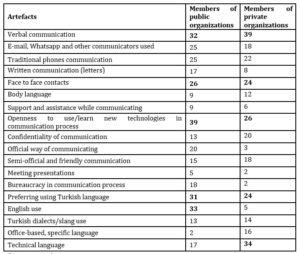
Source: own study
As for other artefacts, the answers differ substantially. In case of behavioural artefacts, in public organizations dominate official behaviour, bureaucracy and objectives-oriented attitude, whereas private organizations stressed rather less official behaviour, team work and task responsibility (table 3). Regarding material artefacts (table 4), representatives of public institutions emphasized the importance of rather official dressing and proper interior design. The latter feature was also highlighted by private firms, but it was accompanied by efficient use of technological devices and exploitation of internal communication systems.
Table 3: Behavioural artefacts

Source: own study
Table 4: Material artefacts
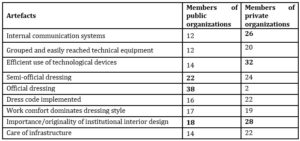
Source: own study
Concerning dominating norms, standards and values, in both kinds of scrutinized organizations, serious attitude to work and expectation of continuity of relations were picked (table 5). However, in public units also honour and sense of stability is important, whereas private firms underlined some aspects of time management. Finally, in case of cultural traits, public organizations emphasized hard work, respect, tolerance, information sharing and loyalty to work-place. The latter one was also highlighted by private companies, but it was accompanied by IT orientation, expectation of job satisfaction and financial benefits (table 6).
Table 5: Norms, standards and values
 Source: own study
Source: own study
Table 6: Cultural traits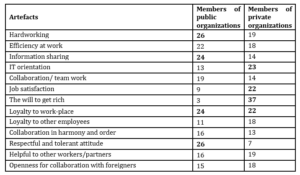
Source: own study
Collaboration Mechanisms for Consistency
Having established the characteristics of organizational culture for Turkish public and private entities, it was possible to work out the mechanisms for consistent cooperation. Below, we present the main characteristics divided according to the organizational culture levels. The analysis was done separately for public and private organizations. Each characteristic corresponds with dedicated mechanisms. What is crucial, the mechanisms created by the authors are just examples – they are supposed to help and encourage managers create their own collaboration mechanisms according to the situation they are in.
Language Consistency
As we can notice in table 7, Turkish public and private organizations are quite similar as for language artefacts and so they require implementing similar consistency mechanisms. It is important to put an emphasis on personal contacts and direct, verbal communication. İt is crucial when starting collaboration with Turkish organizations, but also when the relations develop. Face to face communication is important, so it is necessary to pay regular visits to Turkish partners. İf it is not possible (for instance because of a geographical distance), the Internet tools should be used, so that Turkish partners could see the face of the person they speak to. This way personal, friendly relations develop and the trust between partners is built. Moreover, when employees speak English, they perceive it as an opportunity to practice and develop language skills. Therefore, this aspect of cooperation also should be taken into consideration.
Table 7: Language artefacts characteristic for Turkish public and private organizations and dedicated cooperation mechanisms
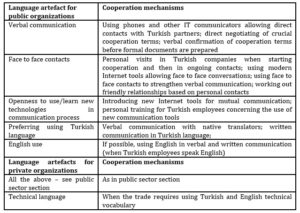
Source: Own study
Behaviour Consistency
As shown in table 8, regarding behavioural artefacts the mechanisms of cooperation with Turkish public and private organizations are different. Public organizations are more formal; there is a need to follow strict rules and codes, and there is a very little space for informal relations. In a private sector, the situation is less formal; it is possible to organize informal meetings outside the company and it is important to pay attention to the integration of cooperating partners. İn this case, friendly atmosphere helps reaching business objectives.
Table 8: Behaviour artefacts characteristic for Turkish public and private organizations and dedicated cooperation mechanisms

Source: Own study
Infrastructure Consistency
The research results from table 9 show that there are some substantial differences when we take into consideration material artefacts’ importance for public and private organizations. In a public sector, it is important to be dressed rather formally, according to a dress code. However, in a private sector, material artefacts are mostly connected with the IT systems and devices the companies implement and use on daily basis. Thus, foreign partners need to adjust to the systems, so that the communication process is effective. İn both cases (public and private), the design of office space is important and often reflects Turkish culture. Thus, other members of an inter-organizational network ought to acknowledge and respect this aspect of relations.
Table 9: Material artefacts characteristic for Turkish public and private organizations and dedicated cooperation mechanisms

Source: Own study
Norms and Values Consistency
With regard to norms and values, first of all it is necessary to respect workers and the rules they follow in everyday routine. Partners ought to respect Turkish customs and culture, and avoid open criticism. İt is also very important to focus on long-term relations by setting common strategic goals. Generally, it is useful to show that we want to get engaged in the cooperation process seriously and for a long period of time. All the actions which express such intentions may be implemented, which gives foreign managers a possibility to be creative in this process.
Table 10: Norms and values characteristic for Turkish public and private organizations and dedicated cooperation mechanisms
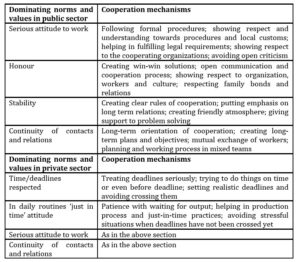
Source: Own study
Cultural Consistency
While cooperating with Turkish partners, it is necessary to pay attention to effective communication systems which will support information transfer between partners. Other findings show that Turkish workers are very loyal to their work places, so it is necessary to show respect to the organizations they work for and to avoid open criticism. Also, Turkish workers are very tolerant, so there is no need for foreign partners to adjust strictly to cultural norms and habits.
İt is also interesting that Turkish organizations are open to the latest technology. Thus, delivering new IT solutions may strengthen cooperation and help build long-term relations. Finally, it is very important to make sure that Turkish partners are financially satisfied. Therefore, business partners should consider implementing different financial bonuses.
Table 11: Cultural traits characteristic for Turkish public and private organizations and dedicated cooperation mechanisms
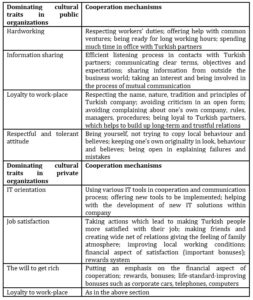
Source: Own study
Conclusion
The presented analysis allowed more thorough understanding of relational characteristics of virtual structures, which constitute crucial value for the development of network science (Watts, 2004; Hudson, 2004; Moller and Wilson, 1995). The authors made a theoretical contribution of conceptualizing a pattern of adjusting to organizational culture in virtual structures. Furthermore, in order to strengthen the practical contribution of the study, the authors presented a possible use of the template on the example of Turkish organizations. The results show that in Turkey the characteristics of organizational culture differ substantially between private and public units, and organizations which collaborate in virtual structures ought to acknowledge this by implementing different mechanisms for each kind of organization.
Finally, the authors would like to stress that the conceptualized pattern and the process of working out mechanisms ought to serve for integrators in virtual organizations as a general template which shows in what way to increase efficiency of relations in a cultural dimension. Although the analysis was done using the method of a multiple case study, the process is universal and it may be implemented by every unit which develops collaboration within virtual structures.
Acknowledgement
The paper was prepared as a part of a scientific project ‘Consistency of virtual networks – collaboration mechanisms’, supported by the Department of Management, General Tadeusz Kościuszko Military University of Land Forces, Wrocław, Poland.
(adsbygoogle = window.adsbygoogle || []).push({});
References
- Bertalanffy, L. (1969), General system theory, George Brazillier, New York.
- Camagni, R. (1995), Global network and local milieu: towards a theory of economic space, In S. Conti, E. J. Malecki and P. Oinas (Eds), The industrial enterprise and its environment: spatial perspectives, Aldershot, Avebury.
- Churchman, C. W. (1971), The design of inquiring systems: Basic concepts of systems and organizations, Basic Books, New York.
- Edelenbos, J. and Klijn, E. H. (2007), ‘Trust in complex decision-making networks: a theoretical and empirical exploration’, Administration and society, 39(1), 25–50. https://doi.org/10.1177/0095399706294460
- Eisenhardt, K. M. (1991), ‘Better Stories and Better Constructs: The Case for Rigor and Comparative Logic’, Academy of Management Review, 16(3), 620– DOI: 10.2307/258921
- Eisenhardt, K. M., and Graebner, M. E. (2007), ‘Theory building from cases: Opportunities and challenges’, Academy of Management Journal, 50(1), 25–
- https://doi.org/10.5465/amj.2007.24160888
- Flieger, M. (2017), Virtual structures in BPM as a good practice to make economic ventures effective – research results, In International forum: The business conditions and legal respect of distribution in Asia, Korea Business and Law Administration, Seoul, 49–71.
- Flyvbjerg, B. (2012), Five misunderstandings about case study research, In Savin-Baden, C. Howell Major (Eds), Qualitative Research: The Essential Guide to Theory and Practice, Routledge, London – New York.
- Håkansson, and Snehota, I. (1989), ‘No business in an island: the network concept of business strategy’, Scandinavian Journal of Management, 5(3), 187–200. DOI:10.1016/0956-5221(89)90026-2
- Haken, H. (1983), Synergetics: An introduction – 3rd edition, Springer, Berlin.
- Hudson, B. (2004), ‘Analyzing network partnership: Benson Revisited’, Public Management Review, 6(1), 75– https://doi.org/10.1080/14719030410001675740
- Kickert, W. J., Klijn, E. H. and Koppenjan, J. (Eds) (1997), Managing complex networks: strategies for the public sector, Sage Publications, London.
- Kilduff, M. and Tsai, W. (2003), Social networks and organizations, Sage Publications, Thousand Oaks.
- Luhmann, N. (2013), Introduction to systems theory, Polity, Cambridge.
- Mayne, J., Wileman, T. and Leeuw, F. (2003), Networks and partnering arrangements: New challenges for evaluation and auditing, In A. Gray, B. Jenkins, F. Leeuw and J. Mayne (Eds), Collaboration in public services: The challenge for evaluation, Transaction Publishers, New Brunswick.
- Miles, M. B. and Huberman, A. M. (2000), Analiza danych jakościowych, Trans Humana, Białystok.
- Miller, J. H. and Page, S. E. (2007), Complex adaptive systems. An introduction to computational models of social life, Princeton University Press, New York.
- Moller, K. and Wilson, D. T. (Eds) (1995), Business marketing: an interaction and network perspective, Kluwer Academic Publishers, Norwell.
- Newman, J., Barnes, M., Sullivan, H. and Knops, A. (2004), ‘Public participation and collaborative governance’, Journal of Social Policy, 33(2), 203– https://doi.org/10.1017/S0047279403007499
- Parsons, T. (1951), The social system, Free Press, New York.
- Peretz, H., Fried, Y. and Levi, A. (2017), ‘Flexible work arrangements, national culture, organizational characteristics, and organizational outcomes: A study across 21 countries’, Human Resource Management Journal, 28(1), 182–200. https://doi.org/10.1111/1748-8583.12172
- Remenyi, D., Williams, B., Money, A. and Swartz, E. (2005), Doing Research in Business and Management. An Introduction to Process and Method, Sage, London.
- Sakai, K. and Kang, N. H. (2000), International strategic alliances: Their role in industrial globalization, OECD, DSTI Working Paper/DOC 5.
- Stocker, F., Abib, G., Furbringer, G. V. and Lemos Lourenco, M. (2017), Virtual teams and multiculturality: differences and impacts of organizational culture in an I.T. company, REBRAE, vol. 11, no 1, 35–55, dec. 2017. DOI: 7213/rebrae.11.001.AO03.
- Toivanen, A. (2017), Changing local to global: finding knowledge sharing barriers between individual motivation factors and organizational culture in virtual team environment, Lappeenranta University of Technology. DOI: 10.13140/RG.2.2.13324.82562
- Wu, J. and Ma, Z. (2018), ‘Misfit or xenophillia: The impact of oversea work experiences on returnee entrepreneurs’ venture capital funding in China’, Nankai Business Review International, 9(1), 19–32.https://doi.org/10.1108/NBRI-06-2015-0016
- Vetrakova, M. and Smerek, L. (2016), ‘Diagnosing organizational culture in national and intercultural context’, Ekonomie a Management, 19(1), 62– DOI: 10.15240/tul/001/2016-1-005
- Yin, R. K. (2014), Case study research: Design and methods, Sage Publications, Thousand Oaks.













